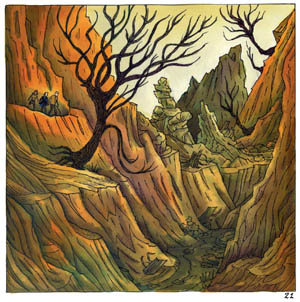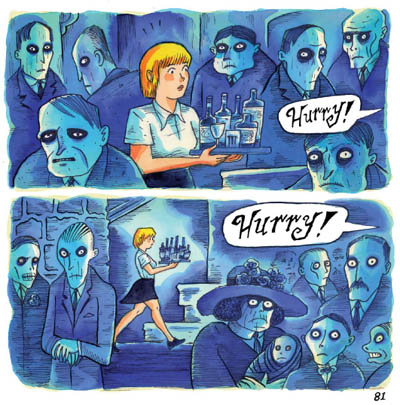 By Richard Sala
By Richard Sala
136 pages, color
Published by Fantagraphics
Richard Sala is one of those creators that holds a fairly unique voice in comics. Many people have tried to replicate his off-beat brand of horror, but ultimately nothing out there quite like his. So with a new graphic novel called The Hidden out, the question for most people won’t be, "Should I read it?" but "When should I read it?" What you’ll find inside is a book that in many ways sums up both Sala’s greatest strengths and weaknesses.
 The Hidden begins in a typical manner for many Sala books; a series of mysterious scenes, with a professor having nightmares followed up quickly by his town being destroyed as he runs. But then, with no warning, the setting jumps slightly in time and we get to the heart of the graphic novel. Our heroes, such as they are, are a young couple named Colleen and Tom who run across the amnesiac professor, even as an unknown force or group has destroyed the nearby city and almost all of its inhabitants. At the mercy of the professor, they find what at first seems to be a safe haven, but then things go from bad to worse and they have to try and rise to the occasion to stop the destruction from shifting to an even greater scale.
The Hidden begins in a typical manner for many Sala books; a series of mysterious scenes, with a professor having nightmares followed up quickly by his town being destroyed as he runs. But then, with no warning, the setting jumps slightly in time and we get to the heart of the graphic novel. Our heroes, such as they are, are a young couple named Colleen and Tom who run across the amnesiac professor, even as an unknown force or group has destroyed the nearby city and almost all of its inhabitants. At the mercy of the professor, they find what at first seems to be a safe haven, but then things go from bad to worse and they have to try and rise to the occasion to stop the destruction from shifting to an even greater scale.
Early on, The Hidden is reminiscent of Edgar Allan Poe’s "Masque of the Red Death" short story, with the scenes of the decadent businessmen locked away from the destruction raining down all around them, assuming that what was outside could never infiltrate their lair. But being Sala, nothing in The Hidden remains static for long, so every time you think you’ve cracked its code something new rears its head. With its ever-sliding setting and characters, though, eventually Sala has to reveal what’s really going on, and that’s one of the weakest points of the book. With little space for the characters to figure it out on their own, we instead have a member of the supporting cast show up with a huge block of exposition, explaining the plot and how it unfolded. It’s an awkward and jarring moment of the book, and while Sala in the past hasn’t been adverse to moments of wholesale exposition, this one seems much more labored and lengthy than in the past.
 When it’s not full of overly heavy exposition, though, there’s a lot about The Hidden that does work. The attack at the Rebirth Foundation shifts that scene from uneasy to terrifying, with Sala pacing out the shifting dynamics of the people in the room in a way that continually ups the fear factor. And when violence shows up almost randomly, there’s that sudden feeling that anything can happen at any time, that at no point in this story is a character safe from harm or death. Even something as simple as a nightmare sequence can grab your attention, and it goes a long way toward smoothing over its exposition issues.
When it’s not full of overly heavy exposition, though, there’s a lot about The Hidden that does work. The attack at the Rebirth Foundation shifts that scene from uneasy to terrifying, with Sala pacing out the shifting dynamics of the people in the room in a way that continually ups the fear factor. And when violence shows up almost randomly, there’s that sudden feeling that anything can happen at any time, that at no point in this story is a character safe from harm or death. Even something as simple as a nightmare sequence can grab your attention, and it goes a long way toward smoothing over its exposition issues.
Sala’s art is strong throughout the graphic novel. His strangely angular creations are once more on display here, but even more than in books like Delphine, I feel like Sala’s making the landscape an equally critical visual element. The desert mesas and buttes tower above the characters as they wander through the wasteland, their ridges and accompanying twisted trees providing an eerie nature to the scenes. Piles of abandoned cars and corpses also regularly show up, presented in a way that at first you can’t help but see them, and then over time they’re almost lurking in the background, an after-thought for the characters who are numbed to their presence. Sala’s colors are also on display here and they’re gorgeous; I love the deep blues he uses for the sky, or the reds and oranges for the landscape. And when we have a creepy nightmare, with the world around a character plunged into a single color, it adds a sinister layer to the scene.
The Hidden isn’t perfect—the exposition is hard to shake, and the ending is even more abrupt than normal (and slightly unsatisfying beyond the initial "gotcha!" moment)—but what Sala does well, he does very well indeed. There’s quite a lot to love in The Hidden, with some scenes in particular that will stick with the reader for a long time. I’d like to see Sala shake these slight faults for his next book, but there’s no doubt in my mind that I’ll be reading it.
Purchase Links: Amazon.com | Powell’s Books
